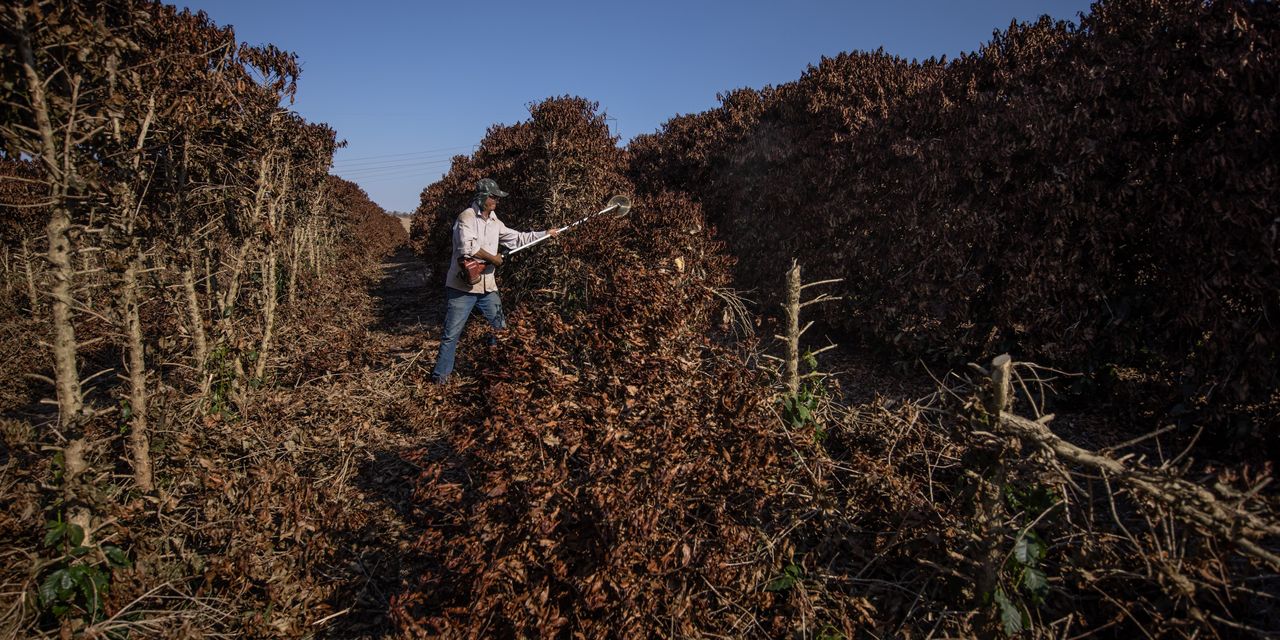
First the drought came to Brazil, then the frost, roiling the world’s top coffee-growing region during the pandemic. Arabica coffee prices at one point last year were nearly twice their levels at the end of 2020. Investors are betting those weather effects, along with supply-chain snarls, will keep prices elevated in 2022.
Arabica coffee futures closed Tuesday at $2.37 a pound, after wrapping up January a little below monthly highs of $2.44. Futures traded at around $1.30 during the same time last year. They finished 2021 up 76%, the largest annual percentage gain since 2010, bringing higher prices for yet another raw material at coffee shops and breakfast tables.
“The coffee market has been on fire,” said Dave Whitcomb, head of research at Peak Trading Research. “This is the type of rally we haven’t seen in years.”
The surge in prices is hitting coffee sellers and roasters, which are passing it on to consumers. Nestlé SA, NSRGY 0.46% which sells at-home coffee through the Starbucks and Nescafé brands, is among those feeling the pressure. Though Nestlé—one of the world’s biggest coffee procurers—managed to avoid price increases for the most part in 2021, the company’s chief financial officer said in October that higher prices are expected this year.
J.M. Smucker Co. ’s bottom line in the coffee segment has also been hurt by extreme weather and supply-chain disruptions. The Ohio-based company, which sells coffee through the Dunkin’ Donuts, Café Bustelo and Folgers brands, raised prices in response, Chief Executive Mark Smucker said during an earnings call in November.
The effects have filtered down to coffee shops. Kafe Kerouac, a coffee shop in Columbus, Ohio, raised prices for all lattes and espresso drinks by 25 cents in the new year. A combination of higher costs for beans, syrups and to-go cups pushed owner Mike Heslop to make the change.
Café Du Monde, in New Orleans, in November raised prices for three varieties of its canned coffee, sold in stores nationwide, by an average of 5% because of higher prices for coffee beans and cans. In the past, the company has hedged against higher costs using futures, said Jay Roman, president at the coffee shop. Mr. Roman said the company would likely buy futures again but prices are too high.
“So far, there haven’t been too many downticks,” Mr. Roman said.
On the other hand, Starbucks Corp. said it had coffee prices locked in for 14 months during its earnings call in late October. Company spokeswoman Megan Lagesse said rising coffee costs haven’t contributed to any price increases experienced by customers.
SHARE YOUR THOUGHTS
Are rising coffee prices changing your consumption habits? Join the conversation below.
Coffee’s continued advance comes as many other commodities that surged to start 2021— such as sugar, wheat and lumber—retreated from those highs.
While analysts say the aftereffects of 2021’s weather are their principal concern, they are also watching for a La Niña weather pattern this year to see how long drought conditions in Brazil will persist.
Though coffee’s price rise can be mostly attributed to weather, higher shipping and freight costs have also helped fuel the rally. The Baltic Dry Index, a proxy for measuring global freight and shipping rates, rose 62% in 2021, its biggest percentage gain since 2016.
In addition to higher costs for beans, coffee companies are facing broader pressures, such as persistent labor issues and seven-year highs in energy, hurting profits. “We don’t think the beans alone are the driver, ” said Aakash Doshi, head of commodities for North America at Citi Research.
Hedge funds and other speculative investors piled into coffee last year with total net long positioning at the end of 2021 climbing to the highest levels in five years, according to Commodity Futures Trading Commission data that includes futures and options.
Prices could come down if the weather outlook improves. Meanwhile, analysts said farmers might decide to not allocate more acreage to coffee trees, which typically take three to four years to mature.
For now, traders are looking for signals about the health of the 2022 crop. Thiago Cazarini, coffee broker at Cazarini Trading Co., lowered his projections for this year’s Brazilian crop because, he said, plants that flowered didn’t yield as much fruit as anticipated.
“We are not as comfortable with the coming crop as we were a year ago,” said Mr. Cazarini, who estimates that coffee will trade between $2.60 and $2.80 a pound for the first half of 2022. “We haven’t seen the highs in coffee yet.”
Write to Hardika Singh at [email protected]
Copyright ©2022 Dow Jones & Company, Inc. All Rights Reserved. 87990cbe856818d5eddac44c7b1cdeb8








